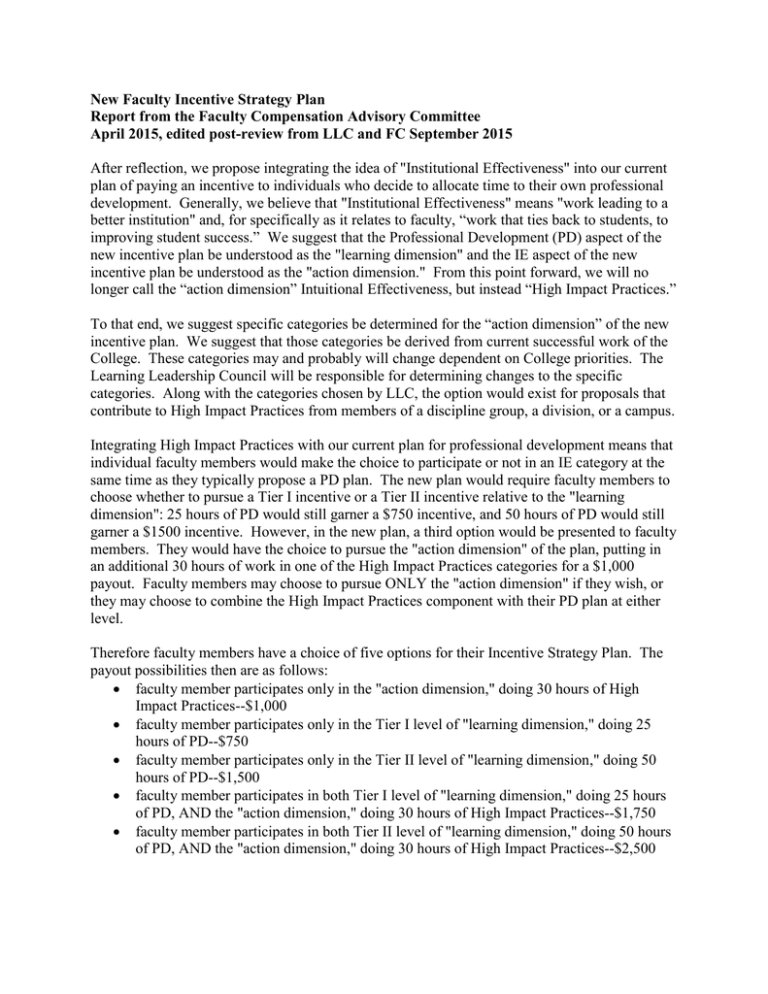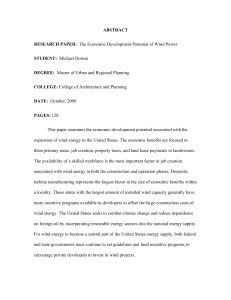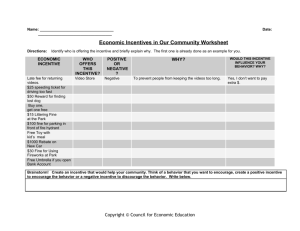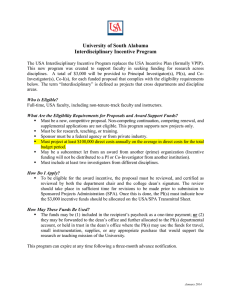Approved Incentive Plan - 2015
advertisement

New Faculty Incentive Strategy Plan Report from the Faculty Compensation Advisory Committee April 2015, edited post-review from LLC and FC September 2015 After reflection, we propose integrating the idea of "Institutional Effectiveness" into our current plan of paying an incentive to individuals who decide to allocate time to their own professional development. Generally, we believe that "Institutional Effectiveness" means "work leading to a better institution" and, for specifically as it relates to faculty, “work that ties back to students, to improving student success.” We suggest that the Professional Development (PD) aspect of the new incentive plan be understood as the "learning dimension" and the IE aspect of the new incentive plan be understood as the "action dimension." From this point forward, we will no longer call the “action dimension” Intuitional Effectiveness, but instead “High Impact Practices.” To that end, we suggest specific categories be determined for the “action dimension” of the new incentive plan. We suggest that those categories be derived from current successful work of the College. These categories may and probably will change dependent on College priorities. The Learning Leadership Council will be responsible for determining changes to the specific categories. Along with the categories chosen by LLC, the option would exist for proposals that contribute to High Impact Practices from members of a discipline group, a division, or a campus. Integrating High Impact Practices with our current plan for professional development means that individual faculty members would make the choice to participate or not in an IE category at the same time as they typically propose a PD plan. The new plan would require faculty members to choose whether to pursue a Tier I incentive or a Tier II incentive relative to the "learning dimension": 25 hours of PD would still garner a $750 incentive, and 50 hours of PD would still garner a $1500 incentive. However, in the new plan, a third option would be presented to faculty members. They would have the choice to pursue the "action dimension" of the plan, putting in an additional 30 hours of work in one of the High Impact Practices categories for a $1,000 payout. Faculty members may choose to pursue ONLY the "action dimension" if they wish, or they may choose to combine the High Impact Practices component with their PD plan at either level. Therefore faculty members have a choice of five options for their Incentive Strategy Plan. The payout possibilities then are as follows: faculty member participates only in the "action dimension," doing 30 hours of High Impact Practices--$1,000 faculty member participates only in the Tier I level of "learning dimension," doing 25 hours of PD--$750 faculty member participates only in the Tier II level of "learning dimension," doing 50 hours of PD--$1,500 faculty member participates in both Tier I level of "learning dimension," doing 25 hours of PD, AND the "action dimension," doing 30 hours of High Impact Practices--$1,750 faculty member participates in both Tier II level of "learning dimension," doing 50 hours of PD, AND the "action dimension," doing 30 hours of High Impact Practices--$2,500 As is done currently, faculty members will submit their Incentive plans, including the new aspect of the "action dimension" that must demonstrate the baseline of 30 hours in one of the High Impact Practices categories, to their deans/directors for approval. Aggregate proposals at the division level will require approval by the campus president. If a discipline group involves more than one campus, all deans involved must agree and sign off. Faculty should note that although the PD work and the High Impact Practices work may/should be connected, any identical activities/development would not be considered for payment under both categories. For the new "action dimension" for one of the High Impact Practices categories, we will ask faculty members to participate in a process of reflection, planning, action, observation, and reflection (again). The process, based loosely on action research and an inquiry model, could ask faculty members to articulate a plan at the beginning of the cycle and report on the results/reflections at the end of the cycle. The documentation would be a simple web-based form that allows the faculty member to respond to some questions, then for the dean to approve electronically. This procedure would not supplant discussion between faculty members and deans, and the timeline for the project would align with the timeline of the PD Plan and the annual evaluation cycle. The High Impact Practice proposal that a faculty will show his or her Dean would incorporate the following four elements: Project description including the topic, question or problem that the faculty member is addressing in the High Impact Practices project and any pertinent background information (planning component/beginning of cycle) Clear learning goals for the High Impact Practices project both for the faculty member and for students, and how it will contribute to High Impact Practices (planning component/beginning of cycle) Appropriate methods, including teaching strategies, and assessment plan (planning component/beginning of cycle) References to related research or nationally recognized guidelines for High Impact Practices category selected, as appropriate. (Service Learning and Undergraduate Research both have nationally recognized guidelines already available, for example, so resources for several of the categories are accessible, provide common language, educate those involved in the new incentive plan related to the category, etc. The “evidence of proof” would be in the completion of the High Impact Practices project and the reflection and analysis containing the following elements. This documentation will be submitted by the faculty member to his or her Dean for approval. Results, including what the faculty member implemented, what results were observed/collected, if the learning outcomes were met, and how the project worked (results/reflection component/end of cycle) Reflection, including a reflection and critique on results, and insights on improvement (results/reflection component/end of cycle) Uploading any documents that the faculty member created or implemented during the process (results/reflection component/end of cycle) The current Professional Development aspect of the Incentive Strategy, the “learning dimension” of personal professional development, will remain unchanged except in terms of the timeline. The Work Team suggests that the FCAC consider making alterations to the timeline for the new Incentive Strategy to better match the faculty’s annual evaluation cycle. Discussion about an individual’s Incentive Strategy Plan will occur during that faculty member’s annual evaluation. However, the decision to participate or not participate is not considered part of the performance evaluation. The meeting time allows for any necessary conversation about proposals for the Incentive Strategy Plan. Thus, we propose the following potential schedule for start in 2017: Incentive Strategy Cycle: July 1, 2017 – June 30, 2019 (two year cycle conducted in even years; aligns with annual evaluation cycle and cycles of Faculty Development and Employee Development) o All previous requirements for the PD Plan would continue to the new format except the timeline, including prior approval of activities by the Dean prior to completion. March 1 – June 30, 2017 (Annual Evaluation; just prior to beginning of future cycle and end of current cycle) o Future Planning - Discuss goals for Incentive Strategy (professional development, any high impact practice ideas) for upcoming year(s). Discussion helps guide faculty member for PD and/or HIP. o *Reflection and Review of Prior Cycle – Discuss and review progress towards PD and/or HIP and connect to future Incentive Strategy plans. o *Faculty member must complete all activities and submit documentation of completion of Incentive Strategy plans prior to annual evaluation deadline. o *Dean makes final approval of Incentive Strategy in online tool by June 30, 201X. March 1 – June 30, 2018 (Annual Evaluation; mid-point of cycle; end of first year and beginning of second year) o Faculty member must have uploaded all activities for Incentive Strategy plans and selected appropriate compensation level prior to annual evaluation deadline Note: This will be the final deadline for selecting compensation level, once deadline has past faculty members cannot increase compensation level, but can claim a lower level. o Reflection and Review of Prior Cycle - Review progress towards PD and/or HIP and connect to future Incentive Strategy plans. o Dean makes final approval of Incentive Strategy in online tool by June 30, 201X. This report is submitted to budget office for budget planning. March 1 – June 30, 2019 (Annual Evaluation; just prior to beginning of future cycle and end of current cycle) o Future Planning - Discuss goals for Incentive Strategy (professional development, any high impact practice ideas) for upcoming year(s). Discussion helps guide faculty member for PD and/or HIP. o Reflection and Review of Prior Cycle – Discuss and review progress towards PD and HIP and connect to future Incentive Strategy plans. o Faculty member must complete all activities and submit documentation of completion of Incentive Strategy prior to annual evaluation deadline. o Dean makes final approval of Incentive Strategy in online tool by June 30, 201X. This report is submitted to the budget office. Fall 2019 – Compensation is awarded in the first paycheck of the next academic year. Deans/directors would also be the final decision maker as to whether or not faculty members complete their plans; faculty members would be responsible for presenting evidence to that effect, in accordance to their proposals and current rules for evidence accepted (conference brochure, work plans, article written, documentation of accomplishment, etc.). This is similar to the current system, where deans/directors review PD plans to ascertain whether faculty did or did not complete the work. Finally, the Work Team concludes that the tool currently used for the PD plan needs to be overhauled. This proposal to start this new Incentive Strategy Plan in 2017 is designed to facilitate moving to the Edge system, which is more user-friendly and can house the documentation for all of the Incentive Strategy (professional development and/or high impact practices). We believe this could be connected to the annual evaluation tool, so faculty members could simply check a box indicating whether they intend to participate in the Incentive Strategy or not. If not, then they just move forward in the evaluation tool. If so, a new window could open allowing for them to write out their plans, somewhat similarly to how the current PD tool allows us to show where we plan to get our points.






